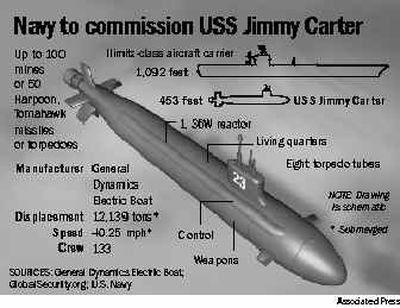Newest sub can tap undersea cables, experts say

WASHINGTON – The USS Jimmy Carter, set to join the nation’s submarine fleet today, will have some special capabilities, intelligence experts say: It will be able to tap undersea cables and eavesdrop on the communications passing through them.
The Navy does not acknowledge that the $3.2 billion submarine, the third and last of the Seawolf class of attack subs, has this capability.
“There are limits to what I can say on the sub’s capabilities, but let’s just say the Jimmy Carter is uniquely capable to perform missions vitally important to the war on terror,” said Rep. Rob Simmons, R-Conn.
But intelligence community watchdogs have little doubt: The previous submarine that performed the mission, the USS Parche, was retired last fall. That would only happen if a new one was on the way.
Like the Parche, the Carter was extensively modified from its basic design, given a $923 million hull extension that allows it to house technicians and gear to perform the cable-tapping and other secret missions, experts say. The Carter’s hull, at 453 feet, is 100 feet longer than the other two subs in the Seawolf class.
“The submarine is basically going to have as its major function intelligence gathering,” said James Bamford, author of two books on the National Security Agency.
Navy public information touts some of the Carter’s special abilities: In the extended hull section, the boat can provide berths for up to 50 special operations troops, like Navy SEALs. It has an “ocean interface” that serves as a sort of hangar bay for smaller vehicles and drones to launch and return.
The Carter, like other submarines, will also have the ability to eavesdrop on communications – what the military calls signals intelligence – passed through the airwaves, experts say. But its ability to tap undersea fiber-optic cables may be unique in the fleet.
To listen to fiber-optic transmissions, intelligence operatives must physically place a tap somewhere along the route. If the stations that receive and transmit the communications along the lines are on foreign soil or otherwise inaccessible, tapping the line is the only way to eavesdrop on it.
The nuclear-powered sub will be commissioned in New London, Conn. After sea trials, the ship will move to its home port in Bangor, Wash.